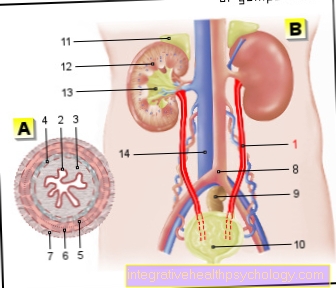Bladder cancer
Synonyms
Bladder tumor, bladder cancer
English: bladder cancer
Also read:
- tumor
- radiotherapy
definition
Bladder cancer is a malignant one tumor of the bladder. Due to its very insidious and late symptoms, it is often only discovered at a later stage. Depending on the extent and differentiation of the bladder carcinoma, it is either surgical or with chemotherapy treated. If the bladder cancer is discovered early, the chances of recovery are very good. This is not least due to the very far-reaching operational possibilities.
Epidemiology

The bladder carcinoma accounts for approx. 3% of all malignant tumors, so it is a rather rare tumor. Men are about 3 times more likely to be affected than women. The age peak of bladder cancer is between the ages of 50 and 60.
root cause
By far the greatest risk factor is that Smoke. But aromatic amines and nitrosamines are also risk factors for the development of bladder carcinoma. There are also some occupational groups that pose an increased risk of cancer. These include employees in the rubber industry, dye production, textile and leather industries as well as painters, varnishers and hairdressers. Further risk factors are long-term therapy with cyclophosphamide or irradiation of the small pelvis as part of the treatment of other cancers.
Learn more about: Quit smoking
Symptoms
Symptoms often come on late. The first symptom of bladder cancer is bloody urine (Macrohematuria), whereby urination is painless. In addition, urinary retention, urgency symptoms or irritative micturition symptoms can occur.
Late symptoms of bladder cancer are like most Tumor diseases, Weight loss, Anemia (anemia) and flank pain. These occur due to urinary outflow disorders, as a result of which the urine backs up in the kidney pelvis and thus leads to pain in the kidney capsule.
Diagnosis

First should blood and urine can be examined in a laboratory. However, there are no tumor markers for bladder carcinoma, which is why, with regard to blood values, especially the Kidney values How creatinine and uric acid are determined in order to assess kidney function. Both the red blood cells (Micro / macro hematuria) can be precisely determined, as well as a cytological diagnosis, which can provide further evidence of a bladder carcinoma. Also should always be a Ultrasonic of the kidneys. This is a non-invasive but very meaningful way of assessing whether a mass or a Kidney enlargement present or not.
After a mass has been determined, a urogram should always be connected. In this way, a tumor of the lower urinary tract can be excluded. Also should be a Computed Tomography of the abdomen and a roentgen- be carried out in order to metastases the thorax lung and assess tumor spread in the abdomen and pelvis.

- Ureter - Ureter
- Transitional epithelium - Urothelium
- Shift layer of the
Mucous membrane - Lamina propria - Inner longitudinal layer -
Stratum longitudinal internum - Outer longitudinal layer -
Stratum longitudinal externum - Middle ring layer -
Circular stratum - Connective tissue covering with
Blood vessels - Tunica adventitia - Aortic fork - Aortic bifurcation
- Rectum - Rectum
- Urinary bladder - Vesica urinaria
- Adrenal gland -
Glandula suprarenalis - Right kidney - Ren dexter
- Renal pelvis - Pelvis renalis
- Lower vena cava - Inferior vena cava
You can find an overview of all Dr-Gumpert images at: medical illustrations
Staging
The Bladder cancer is based on the TNM classification and the grading of the WHO assigned. Depending on the stage, both the prognosis and the therapy are different.
Tis: Carcinoma in situ, i.e. the tumor cells are only in the outermost layer of the bladder wall.
Ta: non-invasive tumor of the outermost wall layer that grows papillary into the bladder cavity.
T1: the subepithelial connective tissue is affected.
T2: the tumor infiltrates the muscles
T2a: the superficial muscle layers are affected
T2b: the deep muscle layers are infiltrated
T3: The tumor infiltrates the surrounding fatty tissue
T3a: only microscopically can tumor cells be detected in adipose tissue
T3b: the fatty tissue is also bare with eye infiltrated by tumor tissue
T4: the tumor infiltrates surrounding organs
T4a: prostate, uterus or vagina are affected
T4b: The pelvic wall or the abdominal wall are affected by tumor tissue
According to the WHO, the tumor is divided into different degrees of malignancy (grades 1-3).
Grade 1: a highly differentiated papillary tumor with low malignant potential
Grade 2: low-grade malignancy. The tumor no longer corresponds completely to the urothelial tissue, but this is still recognizable.
Grade 3: all other stratification disorders are assigned a high malignancy.
-> Read on about bladder cancer therapy
forecast
The radical removal of the bladder has a 5-year survival rate of approx. 75% in the muscle infiltrative stage. Infiltrates the tumor the 5-year survival rate for fatty tissue after complete removal is 40%, if the tumor has infected the neighboring organs only about 25%.
Prevention
The main preventive measure to avoid bladder cancer is not to smoke. The other risk factors are mostly job-related and can hardly be avoided. On the other hand, these risk factors are nowhere near as important as nicotine abuse.
Eating habits could also have an influence on the further course of the disease. More about this under Diet in cancer
Summary
The Bladder cancer belongs to the less common malignant tumor diseases. Because of the late symptoms, many bladder carcinomas are discovered as incidental findings during urine diagnostics. Since both the extent of the intervention and the probability of survival differ significantly depending on the stage, rapid intervention is necessary. Due to the very advanced surgical possibilities today, good and above all acceptable results for the patient can be achieved even with complete removal of the urinary bladder.
However, metastatic bladder carcinomas can no longer be treated well, and depending on the extent of the metastases, they can only be treated as a palliative chemotherapy or Irradiation treated. Due to the proven high risk of bladder cancer in smokers, the most important preventive factor is not smoking.

















.jpg)











